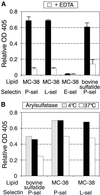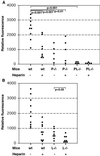Synergistic effects of L- and P-selectin in facilitating tumor metastasis can involve non-mucin ligands and implicate leukocytes as enhancers of metastasis
- PMID: 11854515
- PMCID: PMC122341
- DOI: 10.1073/pnas.261704098
Synergistic effects of L- and P-selectin in facilitating tumor metastasis can involve non-mucin ligands and implicate leukocytes as enhancers of metastasis
Abstract
P-selectin facilitates human carcinoma metastasis in immunodeficient mice by mediating early interactions of platelets with bloodborne tumor cells via their cell surface mucins, and this process can be blocked by heparin [Borsig, L., Wong, R., Feramisco, J., Nadeau, D. R., Varki, N. M. & Varki, A. (2001) Proc. Natl. Acad. Sci. USA 98, 3352-3357]. Here we show similar findings with a murine adenocarcinoma in syngeneic immunocompetent mice but involving a different P-selectin ligand, possibly a sulfated glycolipid. Thus, metastatic spread can be facilitated by tumor cell selectin ligands other than mucins. Surprisingly, L-selectin expressed on endogenous leukocytes also facilitates metastasis in both the syngeneic and xenogeneic (T and B lymphocyte deficient) systems. PL-selectin double deficient mice show that the two selectins work synergistically. Although heparin can block both P- and L-selectin in vitro, the in vivo effect of a single heparin dose given before tumor cells seems to be completely accounted for by blockade of P-selectin function. Thus, L-selectin on neutrophils, monocytes, and/or NK cells has a role in facilitating metastasis, acting beyond the early time points wherein P-selectin mediates interactions of platelet with tumor cells.
Figures





References
-
- Karpatkin S, Pearlstein E. Ann Intern Med. 1981;95:636–641. - PubMed
-
- Gasic G J. Cancer Metastasis Rev. 1984;3:99–114. - PubMed
-
- Fidler I J. Cancer Res. 1990;50:6130–6138. - PubMed
-
- Honn K V, Tang D G, Crissman J D. Cancer Metastasis Rev. 1992;11:325–351. - PubMed
-
- Tanaka N G, Tohgo A, Ogawa H. Invasion Metastasis. 1986;6:209–224. - PubMed
Publication types
MeSH terms
Substances
Grants and funding
LinkOut - more resources
Full Text Sources
Other Literature Sources

